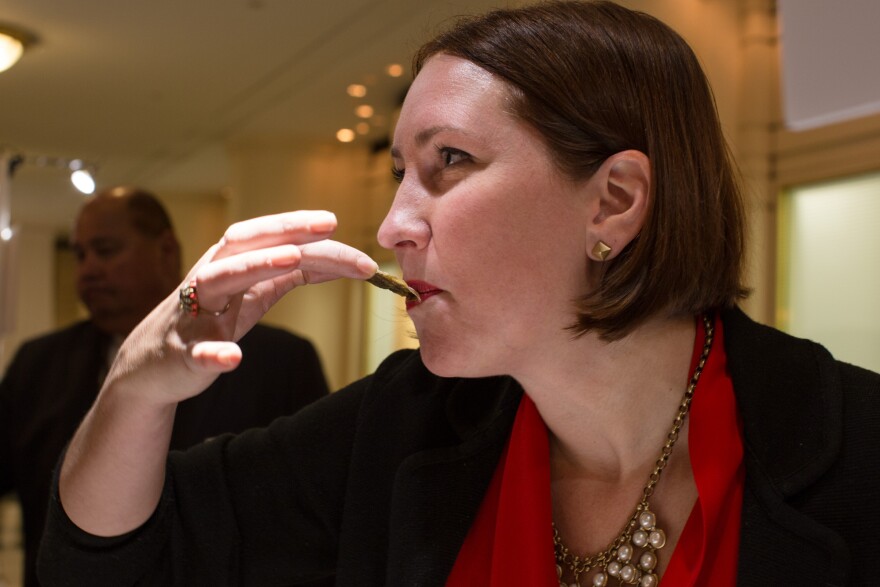When it needs to serve 75,000 raw oysters to 3,000 people in one weekend, Washington D.C.'s landmark Old Ebbitt Grill calls in reinforcements. It hires expert oyster shuckers to help out with its Oyster Riot event each year. And for most of the last 20 years, those experts have included 59-year-old George Hastings.
Hastings, white-bearded and sturdy, with an easy, Santa Claus-style belly laugh, has been shucking for about 40 years. He's a two-time national champion (yes, there is such an event) and has competed internationally in what's billed as the , in Ireland.
"In 50 years of that competition in Galway, Ireland, there's only been two Americans that's ever won. And then there's yours truly," Hastings says with a smile and a wink.

Alas, he came in second in Ireland a few years ago — but that hasn't damped his enthusiasm. At least a dozen times a year, Hastings travels the country to ply his craft at oyster festivals and competitions. Often, he sees the same faces at these events — other itinerant shuckers on the "oyster circuit" and those that run the events. Over the years, he's grown to view them as a sort of extended family.
On weekends and sometimes weeknights, he gathers his buddies, and often, his son, his brother Bob and some nephews. They bring a couple of nubby oyster knives with egg-shaped handles they've modified themselves — "Chesapeake stabbers," they call them — and several pairs of cotton work gloves to protect their hands.
"The shells are more dangerous than the knife," Hastings says. That's because the fast-growing, farm raised oysters commonly eaten today don't develop the kind of thicker, rounder shells that wild oysters do. They just don't have as much time to mature. And for the record, he says, he's sustained very few injuries over the years. "I never ran the knife into my hand, so to say."
Hastings grew up in Baltimore, the son of a lithographer — not a fisherman — but he was near enough to water that it somehow got into his veins.
Sometime in the late 1960s, when he was a teenager, a neighbor came knocking on his door, asking if he'd like a job shucking oysters. The neighbor worked in an oyster factory during the day, but was offered odd jobs at private oyster parties at night and needed a hand.
"My first assignment was [as] an oyster steamer," Hastings recalls. "My responsibilities were to build a fire pit, put a steel plate on the fire pit, build a roaring fire, dump the oysters on the steel plate, cover them with wet burlap, and as they were done, serve them. That was my apprenticeship," he says.
Once he graduated to raw oyster shucker, he really fell in love with the repetition, the precision and the people he bantered with while working.
Shucking, however, was never his day job: He recently retired from a job as a highway engineer with the state transportation department. Indeed, oyster shucking doesn't pay much, says Jason Ruth. "It's a manual job and it can be strenuous." It's also one of the dirtiest jobs around.

Ruth runs one of a handful of processing plants left on Maryland's Eastern Shore — Harris Seafood Company — and has known Hastings for years. Ruth organizes groups of shuckers to help restaurants staff up for events like the Oyster Riot. He says a "$125 event rate is typical, and maybe [an extra] $150 in tips." Most people don't do it for the money.
What makes a good shucker, Ruth says, is "speed and quality. They don't cut the meat."
Hastings agrees. "If an oyster is shucked properly, it's like a water balloon. And it you don't puncture that water balloon, you save most of the juices."
When we ask him about the right way to open an oyster, Hastings says with a laugh: "Any way you can get the oyster open." But clearly he's kidding, because he proceeds to show us his preferred method: stabbing. It's more precise than it sounds.
It involves thrusting a knife in a certain spot on the bivalve's side to separate the two shells, cutting out a muscle, and flipping it onto the flat side to serve it. This makes the oyster look bigger because it's "sitting up high." Others prefer serving it on the cupped side to hold more condiments.
There are other opening methods, like the hinge method preferred by many chefs. No one way is better than another, he says, it's all about how you were taught.

As for Hastings' preferred eating method, if you don't have a fork, gently pick up the oyster with your lips, as if giving it a kiss. "Don't put your mouth on that shell," he warns, because you'll get a mouthful of grit.
He chats and laughs all night with the hundreds who line up to visit his stall at the Oyster Riot, where he and his brother are serving Holy Grail oysters from the Chesapeake Bay on the half shell.
"It's the only job in the world that I've ever had where everybody has a smile," he says. The work can be grueling at times, but he'll only quit "when it stops being fun."
April Fulton is a former Salt editor and freelance writer in the Washington, D.C., area.
Copyright 2021 NPR. To see more, visit https://www.npr.org. 9(MDEwMTk5OTQ0MDEzNDkxMDYyMDQ2MjdiMw004))




